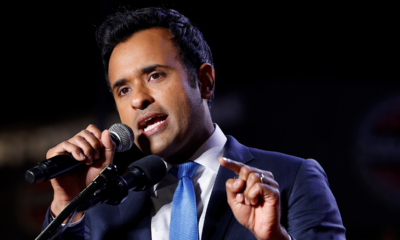California
California air regulators to vote on contentious climate program to cut emissions
SACRAMENTO, Calif. (AP) — California air regulators will vote Friday on changes to a key climate program aimed at reducing planet-warming emissions from transportation fuels that has a wide swath of critics — from environmentalists to the oil industry.
The California Air Resources Board is set to decide on changes to the low carbon fuel standard, or LCFS, which requires the state to reduce the climate impact of transportation fuels by incentivizing producers to lower their emissions.
The proposal would increase the state’s emission reduction targets and fund charging infrastructure for zero-emission vehicles. It would also phase out incentives for capturing methane emissions from dairy farms to turn into fuel.
But environmental groups have criticized the program for stimulating the production of biofuels, which are derived from sources including plants and animal waste, when they say the state should focus more on supporting power for electric vehicles. They argue the proposal fails to adequately address those concerns.
The oil industry, state lawmakers and others have said the agency hasn’t been transparent about how the proposed updates could increase gas prices.
Agency staff released a cost-benefit analysis last year estimating that the initial proposal could have led to an increase in gas prices by 47 cents per gallon by 2025. But staff has not repeated the analysis since later updating the proposal, and the agency contends it cannot accurately predict gas prices.
“If you’re going to ask drivers to pay a lot, which is what this program proposal is going to do, I think you need to be able to make the case that it’s worth paying for,” said Danny Cullenward, a climate economist with the University of Pennsylvania’s Kleinman Center for Energy Policy.
Gas prices could increase by as high as 85 cents a gallon by 2030, and $1.50 per gallon by 2035 under the proposal, according to an estimate from Cullenward. Cullenward said his figures and the estimates initially released by board staff are not an apples-to-apples comparison, in part because his projection uses 2023 dollars and theirs used 2021 dollars.
Jodie Muller, chief operating officer for the Western States Petroleum Association, said the group supports the program overall but wants the agency to be more transparent about how it leads to an increase in gas prices.
The California Air Resources Board says the program will ultimately lower the cost of sustainable transportation fuels.
The agency first approved the low carbon fuel standard in 2009, and it was the first of its kind in the nation. It is part of California’s overall plan to achieve so-called carbon neutrality by 2045, meaning the state will remove as many carbon emissions from the atmosphere as it emits. The state has passed policies in recent years to phase out the sale of new fossil-fuel powered cars, trucks, trains and lawn mowers.
“The low carbon fuel standard has already successfully created lower-cost, lower-carbon alternatives, and the benefits of the proposal vastly outweigh those costs,” Steven Cliff, the agency’s executive officer, said at a news briefing last month.
The vote comes a day after Democratic Gov. Gavin Newsom called the state Legislature into a special session to protect some of California’s environmental and other liberal policies ahead of former President Donald Trump’s second term in office.
The Trump administration in 2019 revoked California’s ability to enforce its own tailpipe emissions standards. President Joe Biden later restored the state’s authority, which was upheld in federal court.
Future challenges from the Trump administration could lead to long court battles, said David Pettit, a senior attorney with the Center for Biological Diversity’s Climate Law Institute.
“In the meantime, I think we still need something … to enhance the development of electric vehicles and the electric vehicle infrastructure,” Pettit said. “The LCFS is a way that we might be able to do that.”
___
Austin is a corps member for the Associated Press/Report for America Statehouse News Initiative. Report for America is a nonprofit national service program that places journalists in local newsrooms to report on undercovered issues. Follow Austin on Twitter: @ sophieadanna

California
Placer County crews rescue baby, family from home surrounded by raging river

PLACER COUNTY, Calif. (KGO) — Heavy rain and flooding impacted Northern California over the weekend, leading to rescues and evacuations throughout the region.
In Placer County, emergency crews carefully and slowly rescued a baby in a carrier, sliding it on a ladder over a rushing river.
The raging South Yuba River overtook the home, where nine people were rescued by the Truckee Fire Protection District.
As of Monday morning, the Placer County Sheriff’s Office said an evacuation warning continues to be in effect for areas along the South Yuba River between Donner Pass Road and Cisco Road.
The storm is also swamping parts of Humboldt County, where the sheriff’s office shared pictures of goats stranded on someone’s doorstep.
This is near the Freshwater area – near Arcata, where high water forced several evacuations.
Crews arrived in jet skis to assist residents.
In Redding, one person died after major flooding.
Water took over streets and entire neighborhoods.
Several people had to be rescued, and Interstate 5 was also flooded, impacting holiday drivers.
LIVE UPDATES: Storms flood parts of NorCal with heavy rain as alerts expand to entire Bay Area
In Mendocino County, Willits received more than 6 inches of rain in 48 hours, flooding parks in the area.
With more rain in the forecast, rescue crews are prepared and people are reminded not to ever drive through standing water.
Copyright © 2025 KGO-TV. All Rights Reserved.
California
Flash flooding in Northern California leads to soaked roads, water rescues and a death

REDDING, Calif. — Heavy rain and flash flooding soaked roads in northern California, leading to water rescues from vehicles and homes and at least one confirmed death, authorities said Monday.
In Redding, a city at the northern end of the Central Valley, one motorist died after calling 911 while trapped in their vehicle as it filled up with water, Mayor Mike Littau posted online Monday. Police said they received numerous calls for drivers stranded in flooded areas.
“Redding police officer swam out into the water, broke the windows and pulled victim to shore. CPR was done but the person did not live,” Littau wrote.
The weather in the coming days could be even more dangerous, he warned.
The National Weather Service expected more rain through the Christmas week as a series of atmospheric rivers was forecast to make its way through Northern California. A large swath of the Sacramento Valley and surrounding areas were under a flood watch through Friday.
The weather pattern was expected to intensify by midweek, which could lead to potential mudslides, rockslides and flooding of creeks and streams, forecasters warned. Up to 6 feet of snow was predicted for parts of the Sierra Nevada and winds could reach 55 mph in high elevations by Wednesday.
Southern California can also expect a soggy Christmas, with heavy rain in the forecast starting Tuesday evening. The National Weather Service urged people to make backup plans for holiday travel.
In Redding and surrounding areas, between 3 and 6 inches had fallen by Sunday night, the National Weather Service said.
As of Monday morning, local roads in Redding remained flooded as street crews worked to clear debris and tow out abandoned cars.
Dekoda Cruz waded in knee-deep muddy water to check on a friend’s flooded tire business, where the office was littered with a jumble of furniture and bobbing tires.
In the mountain pass area of Donner Summit, firefighters in Truckee extended a ladder to stranded residents at a house along the South Yuba River, the fire department posted online Sunday. No injuries were reported.
Atmospheric rivers are long, narrow bands of water vapor that form over an ocean and flow through the sky, transporting moisture from the tropics to northern latitudes.
Earlier this month, stubborn atmospheric rivers that drenched Washington state with nearly 5 trillion gallons of rain in a week, threatening record flood levels, meteorologists said. That rainfall was supercharged by warm weather and air plus unusual weather conditions tracing back as far as a tropical cyclone in Indonesia.
California
Christmas storm still on track to hit Southern California. Here is when the heaviest rain arrives

Southern California is preparing for a powerful winter storm over the Christmas holiday, with forecasters warning of heavy rainfall, gusty winds, and potential flooding across the region.
According to the National Weather Service, the storm will bring an extended period of significant rainfall from Tuesday through Saturday, with totals expected to reach 4 to 8 inches across coastal and valley areas and 8 to 12 inches or more in the foothills and mountains by Saturday evening. Officials are urging residents to take necessary precautions, as flooding and debris flows could pose serious risks throughout the week.
The first, and most impactful, surge of rain is expected Tuesday night into Wednesday, when a moderate to strong atmospheric river will target the area. During this period, rainfall totals could reach 2 to 5 inches in coastal and valley regions and 5 to 10 inches in foothills and mountain areas, with hourly rates of 0.75 to 1.25 inches possible. The extended rainfall and intensity raise concerns about widespread urban flooding, mud and debris flows, and hazardous driving conditions, particularly during one of the busiest travel periods of the year.
A flood watch has been issued for all four counties from Tuesday afternoon through Wednesday evening, and the National Weather Service recommends that residents begin taking protective actions now.
In addition to heavy rain, strong southerly winds are expected Tuesday and Wednesday, particularly in the mountains and foothills, with the potential to knock down trees and cause power outages. Officials are advising residents to avoid swollen creeks and rivers, refrain from unnecessary ocean activity, and take precautions such as parking vehicles away from tall trees during periods of strong wind.
Forecasters emphasized that the timing and intensity of the storm could still change and encouraged residents to monitor updates from the National Weather Service and KTLA’s meteorologists.
-

 Iowa1 week ago
Iowa1 week agoAddy Brown motivated to step up in Audi Crooks’ absence vs. UNI
-

 Maine1 week ago
Maine1 week agoElementary-aged student killed in school bus crash in southern Maine
-

 Maryland1 week ago
Maryland1 week agoFrigid temperatures to start the week in Maryland
-

 New Mexico7 days ago
New Mexico7 days agoFamily clarifies why they believe missing New Mexico man is dead
-

 South Dakota1 week ago
South Dakota1 week agoNature: Snow in South Dakota
-

 Detroit, MI1 week ago
Detroit, MI1 week ago‘Love being a pedo’: Metro Detroit doctor, attorney, therapist accused in web of child porn chats
-

 Health1 week ago
Health1 week ago‘Aggressive’ new flu variant sweeps globe as doctors warn of severe symptoms
-

 Maine7 days ago
Maine7 days agoFamily in Maine host food pantry for deer | Hand Off




















